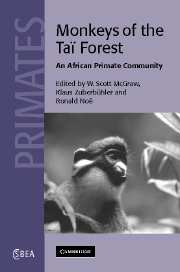Book contents
- Frontmatter
- Contents
- List of Contributors
- Preface
- 1 The monkeys of the Taï forest: an introduction
- Part I Social behavior
- 2 The social systems of the guenons
- 3 How small-scale differences in food competition lead to different social systems in three closely related sympatric colobines
- 4 The structure of social relationships among sooty mangabeys in Taï
- Part II Anti-predation strategies
- Part III Habitat use
- Part IV Conservation
- Appendix
- Index
- Plate section
- References
2 - The social systems of the guenons
Published online by Cambridge University Press: 30 July 2009
- Frontmatter
- Contents
- List of Contributors
- Preface
- 1 The monkeys of the Taï forest: an introduction
- Part I Social behavior
- 2 The social systems of the guenons
- 3 How small-scale differences in food competition lead to different social systems in three closely related sympatric colobines
- 4 The structure of social relationships among sooty mangabeys in Taï
- Part II Anti-predation strategies
- Part III Habitat use
- Part IV Conservation
- Appendix
- Index
- Plate section
- References
Summary
Introduction
The social system of a species includes the nature of the interactions of individuals between and within social units and the spatial distribution of different age/sex classes. For primates, theories concerning the evolution of social systems are typically based on field data from a restricted number of species, with a clear bias towards species living in more open habitats (Sterck et al. 1997). This is problematic because the forest is a major primate habitat, housing a large number of primate species. The social behavior of most forest-living primates is not well described, primarily due to the difficulties in accessibility and observation conditions. In this respect the forest guenons (Cercopithecus spp.) are of particular interest for evolutionary theories because they represent a major group of Old World primates.
It is theorized that female primates live in social groups because of anti-predation benefits (van Schaik 1983, van Schaik & van Hoof 1983) and because group-living improves their capacity to defend resources against other groups of conspecifics (Wrangham 1980). Across species, female primates differ in the types of social relations they maintain with one another to achieve these goals. It has been proposed that the relative strengths of inter- and intra-group competition are the two main factors that determine the nature of the females' social relationships and their social system (Sterck et al. 1997, Table 2.1).
Across primate species, inter-group encounters can vary from friendly intermingling to hostile fights.
- Type
- Chapter
- Information
- Monkeys of the Taï ForestAn African Primate Community, pp. 51 - 71Publisher: Cambridge University PressPrint publication year: 2007
References
- 5
- Cited by



